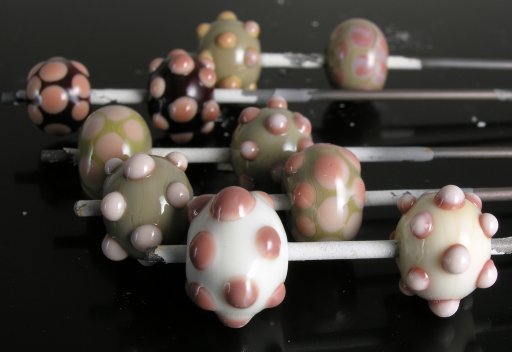I thought it would be fun to play with neutrals, specifically some of the "new" (that is, they've been around for the last five years or more but weren't available when I first started lampworking in 96) hand pulled (?) effetre colors such as silver pink/opal yellow, (can't tell ’em apart) tongue pink, powder pink, sage green, and avocado green (though in my opinion, both the powder and either the sage or the avocado—I never can keep ’em straight) are more properly browns.
Normally I have a difficult time using such expensive glass, but since these were made specifically for a good cause, it was easier to justify using the yummy, tertiary pastels I've been buying (to the point that I have a pound or more of each), but couldn't bring myself to “waste”.
So starting with the mandrel in front, we have ivory with powder pink dots, then two mandrels’ worth of sage green beads with powder pink dots, then a very dark brown with powder pink dots, and finally, sage green with opal yellow/silver pink dots.
So for the eight beads in front the dots, though they show considerable variation, are all made with exactly the same glass, in various states between unstruck (the pale pink) to partially struck (coral) to completely struck (pinkish brown). The heat to make raised dots renders the powder pink pale. This can then be struck to brown by letting the bead cool, then gently reheating till you're happy with the depth of color. Heating raised dots more, in a hotter region of the flame de-strikes (returns the pale color) to the tips of the dots, giving the attractive effect of a pale dot with a ‘base collar’ of the darker color.
And I've decided that powder pink, despite its reminding me of country-craft dusty rose (blech), is actually quite nice for these earth-toned color schemes.
The last pair of beads is dotted with a silver bearing color. This (if I understand correctly, which sadly is in doubt) is a little different: the silver particles grow in size during the striking process, proceeding through yellow and working their way to the blue end of the spectrum. Thus the raised dots, which are golden shifting to red (pink) are less struck than the sunk in ones which are reddish starting to shade to pale blue-violet.
In any event, this sort of playing around is a great way to explore the color chemistry of various glasses.
file created 24apr07
Unless otherwise noted, text, image and objects depicted therein copyright 1996--present sylvus tarn.
Sylvus Tarn